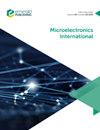0.25µm工艺下的高性能RC-INV触发SCR
IF 0.8
4区 工程技术
Q4 ENGINEERING, ELECTRICAL & ELECTRONIC
引用次数: 0
摘要
目的众所周知,集成电路的静电放电(ESD)保护设计非常重要,其中可控硅(SCR)是最常用的ESD保护器件之一。但是传统的可控硅存在触发电压过高、回跳后保持电压过低、导通时间过长的缺点。本文的目的是按照0.25µm工艺下的设计窗口设计高性能的可控硅,为降低触发电压、提高保持电压和缩短导通时间的可控硅设计提供一种新的方案。在传统可控硅的基础上,介绍了一种RC-INV触发电路。通过理论分析、TCAD仿真和带出验证表明,RC-INV触发可控硅在保持良好鲁棒性的前提下,可以降低触发电压,提高保持电压,缩短器件的导通时间。结果RC-INV触发可控硅具有良好的性能,测试表明可以获得几乎无回跳的传输线脉冲曲线。与传统可控硅相比,触发电压从32.39 V降低到16.24 V,保持电压从3.12 V提高到14.18 V,导通时间从29.6 ns降低到16.6 ns,与人体模型达到18 kV+的水平相比降低了43.9%。在0.25µm BCD工艺下,本研究提出了一种高性能RC-INV触发可控硅ESD保护装置。本文所做的工作对可控硅ESD保护器件的设计具有一定的指导意义。本文章由计算机程序翻译,如有差异,请以英文原文为准。
A high performance RC-INV triggering SCR under 0.25 µm process
Purpose
As it is known, the electrostatic discharge (ESD) protection design of integrated circuit is very important, among which the silicon controlled rectifier (SCR) is one of the most commonly used ESD protection devices. However, the traditional SCR has the disadvantages of too high trigger voltage, too low holding voltage after the snapback and longer turn-on time. The purpose of this paper is to design a high-performance SCR in accordance with the design window under 0.25 µm process, and provide a new scheme for SCR design to reduce the trigger voltage, improve the holding voltage and reduce the turn-on time.
Design/methodology/approach
Based on the traditional SCR, an RC-INV trigger circuit is introduced. Through theoretical analysis, TCAD simulation and tape-out verification, it is shown that RC-INV triggering SCR can reduce the trigger voltage, increase the holding voltage and reduce the turn-on time of the device on the premise of maintaining good robustness.
Findings
The RC-INV triggering SCR has great performance, and the test shows that the transmission line pulse curve with almost no snapback can be obtained. Compared with the traditional SCR, the trigger voltage decreased from 32.39 to 16.24 V, the holding voltage increased from 3.12 to 14.18 V and the turn-on time decreased from 29.6 to 16.6 ns, decreasing by 43.9% the level of human body model reached 18 kV+.
Originality/value
Under 0.25 µm BCD process, this study propose a high-performance RC-INV triggering SCR ESD protection device. The work presented in this paper has a certain guiding significance for the design of SCR ESD protection devices.
求助全文
通过发布文献求助,成功后即可免费获取论文全文。
去求助
来源期刊

Microelectronics International
工程技术-材料科学:综合
CiteScore
1.90
自引率
9.10%
发文量
28
审稿时长
>12 weeks
期刊介绍:
Microelectronics International provides an authoritative, international and independent forum for the critical evaluation and dissemination of research and development, applications, processes and current practices relating to advanced packaging, micro-circuit engineering, interconnection, semiconductor technology and systems engineering. It represents a current, comprehensive and practical information tool. The Editor, Dr John Atkinson, welcomes contributions to the journal including technical papers, research papers, case studies and review papers for publication. Please view the Author Guidelines for further details.
Microelectronics International comprises a multi-disciplinary study of the key technologies and related issues associated with the design, manufacture, assembly and various applications of miniaturized electronic devices and advanced packages. Among the broad range of topics covered are:
• Advanced packaging
• Ceramics
• Chip attachment
• Chip on board (COB)
• Chip scale packaging
• Flexible substrates
• MEMS
• Micro-circuit technology
• Microelectronic materials
• Multichip modules (MCMs)
• Organic/polymer electronics
• Printed electronics
• Semiconductor technology
• Solid state sensors
• Thermal management
• Thick/thin film technology
• Wafer scale processing.
 求助内容:
求助内容: 应助结果提醒方式:
应助结果提醒方式:


